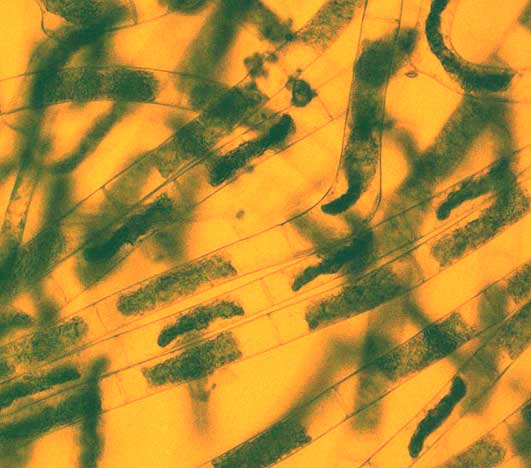Excerpts from Jim Conrad's
Naturalist Newsletter

from the December 2, 2012 Newsletter issued from the valley of the Dry Frio River in northern Uvalde County, southwestern Texas, on the southern border of the Edwards Plateau; elevation ~1750m (~5750 ft); N29.62°, W99.86°; USA
MOUGEOTIA GREEN ALGA
This week some scum turned up in a stagnate pool beside the river striking me as a little different from our previous ones. It was yellowish green and more frothy with bubbles of the oxygen it was producing as a byproduct of photosynthesis than our previous scums. Its filaments felt softer and squishier than those. You can see my fingers dipping into a blob of it above.
Under the microscope, it looked completely different from our previous algae, as shown below:

What's unusual about those longish cells is that is that they appear to be mostly empty, and the cells' contents are irregular in shape.
This time my alga-identification efforts were aided by the online key to algae at http://www.algalweb.net/search1.htm.
That key first needed to know that our alga is filamentous, which means that its longish cells are attached to one another end-to-end. Very many alga species are unicellular or colonial but not filamentous. The next feature keyed was that our filaments were non-branching. Then I had to learn what pyrenoids are to see if our alga's cells had them. It turned out that pyrenoids are organelles that fix carbon dioxide within chloroplasts, and under the microscope look like little bumps. At this point my analysis was getting shaky, but I did see bumps on what might be the chloroplast, so I said "present."
The key responded with "Mougeotia is the commonest genus answering to this description," so I looked for images of the alga Mougeotia on the Internet, found them to look more or less like ours, and after more study I grew pretty convinced that that's what we have, though I can't guess which species it is.
Mougeotia is described as a filamentous green alga whose cells contain a single ribbonlike chloroplast nestled between two large vacuoles and surrounded by a layer of cytoplasm. Vacuoles are basically storage bubbles in cells, so the "empty" spaces we're seeing at the ends of each cell are vacuoles. Cytoplasm is just the cell's gel-like substance containing the cells tiny organs, or organelles. The shriveled-looking, irregularly shaped, dark object in each cell is the "single ribbonlike chloroplast," a chloroplast being an organelle that conducts photosynthesis and other chemical reactions for the cell.
Further reading informs me that this ribbonlike chloroplast is extraordinary. It can rotate about its long axis as it orients itself perpendicularly to incoming light -- much like a mechanized solar panel!
Next I needed to put all this information into some kind of context. Was this remarkable alga common or rare? Just how unique was it?
It turns out that the previous two algae species found in the Dry Frio behind the cabin -- Spirogyra and Zygnema -- belong to the same family of filamentous, green algae, the Zygnematacae, as our Mougeotia. So, the first three algae I've identified in the Dry Frio behind the cabin are all members of the Zygnematacae.
On Wikipedia I read that the Zygnemataceae is notable among other families of alga for its diversely shaped chloroplasts, such as helical in Spirogyra, stellate in Zygnema, and flat in Mougeotia. The family is cosmopolitan, and the three genera Spirogyra, Zygnema and Mougeotia are by far its most commonly encountered genera. In one study of North American members of the Zygnemataceae it was found that 95% of the algae identified belonged to those three genera.
So, it seems that if you find a filamentous green alga forming scum, the chances are very good that your scum will be composed of one or more members of the Zygnemataceae. Also, within the Zygnemataceae the three algae genera we have identified so far in the little Dry Frio River behind the cabin are exactly the three we might have expected to find there.
from the December 29, 2013 Newsletter issued from the Frio Canyon Nature Education Center in the valley of the Dry Frio River in northern Uvalde County, southwestern Texas, on the southern border of the Edwards Plateau; elevation ~1750m (~5750 ft); N29.62°, W99.86°; USA
BIG, GREEN BLOBS
Under the microscope we've identified several species of algae found in the Dry Frio but now I'm realizing that even if I can recognize them under the microscope, I can't in real life. Now I'm going back and relating the names to how they look in the field.
One alga species catching the eye nowadays forms bushel-basket-size-and-larger, emerald-green blobs in the Dry Frio's deeper water -- knee deep or so. Over time the blobs expand and when they reach the water's surface their exposed parts form a yellowish-green scum. At first glance you don't even notice that the pretty-looking, billowy submerged blobs produce the scum. You can see how all this looks below:

By noticing the floating sycamore leaf at the picture's lower, left you can gain an idea of how large the submerged green blobs are.
A smidgeon of a blob brought to Juniper House and placed below the microscope's lens revealed the filaments appearing below:

We've seen that very thing, calling it Mougeotia. So, now we know that Mougeotia makes those marvelous big blobs that look like they're bubbling up from the river's floor. Physiologically, Mougeotia species are famous for their cells' flat, ribbonlike chloroplasts, which orient themselves relative to the light. In the last picture the irregular-shaped objects in each cell are the chloroplasts twisting this way and that.
Another odd feature of Mougeotia filaments is that they "genuflect" -- a straight filament will abruptly bend sharply and grow off at an angle. A genuflecting filament is seen in the center of the above picture.